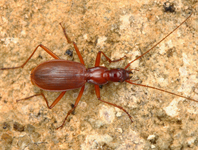Abstract
Eight new species of Duplominona (Platyhelminthes, Proseriata, Monocelididae) are described from the Pacific coast of Panama. They differ from their congeners in the detailed morphology of hard structures associated with the copulatory organ. Duplominona basidilatata n. sp. has a cirrus provided with 5–6 rows of triangular spines, 3–8 μm long, with a large, flat, poorly sclerotized basis. D. hystricina n. sp. has 10–12 rows of needle-shaped spines, 3.5–15 μm long, with a swollen basis. The cirrus of D. hyperhystricina n. sp. is provided with 20–25 rows of slender spines 1.5–9 μm long, with a recurved distal tip. In D. veracruzensis n. sp., cirrus spines increase abruptly in size, from 1.5–2 μm to 6–7 μm. D. uniserta n. sp. has a very long seminal vesicle and a small cirrus, provided with one girdle of hook-shaped spines, 3–5 μm long. D. macrodon n. sp. has one girdle of large, triangular spines, 8–18 μm long. Both D. trimera n. sp. and D. pseudotrimera n. sp. have a tripartite tail, and their cirrus is provided with a stylet. In D. trimera n. sp., the stylet is surrounded by 15–20 rows of spines, 6.5–10 μm long, while D. pseudotrimera n. sp. has 6–8 rows of large spines, 7–22 μm long. D. uniserta n. sp. and D. aduncospina Curini-Galletti, 2019 from the Caribbean coast of Panama have few rows of morphologically nearly identical spines, and are possible candidates as trans-isthmian geminate species. The presence of species with a tripartite tail on both sides of the Isthmus of Panama suggests the possibility of further geminate species pairs; however, no support could be obtained on the basis of the morphology of their hard structures. Five of the eight new species of Duplominona have been found in a single locality, and the diversity of genus along the Pacific coast of Panama may be far higher than present contribution suggests.
References
Appeltans, W., Ahyong, S.T., Anderson, G., Angel, M.V., Artois, T., Bailly, N., Bamber, R., Barber, A., Bartsch, I., Berta, A., Błazewicz-Paszkowycz, M., Bock, P., Boxshall, G., Boyko, C.B., Brandão, S.N., Bray, R.A., Bruce, N.L., Cairns, S.D., Chan, T.-Y., Cheng, L., Collins, A.G., Cribb, T., Curini-Galletti, M., Dahdouh-Guebas, F., Davie, P.J.F., Dawson, M.N., De Clerck, O., Decock, W., De Grave, S., de Voogd, N.J., Domning, D.P., Emig, C.C., Erséus, C., Eschmeyer, W., Fauchald, K., Fautin, D.G., Feist, S.W., Fransen, C.H.J.M., Furuya, H., Garcia-Alvarez, O., Gerken, S., Gibson, D., Gittenberger, A., Gofas, S., Gómez-Daglio, L., Gordon, D.P., Guiry, M.D., Hernandez, F., Hoeksema, B.W., Hopcroft, R.R., Jaume, D., Kirk, P., Koedam, N., Koenemann, S., Kolb, J.B., Kristensen, R.M., Kroh, A., Lambert, G., Lazarus, D.B., Lemaitre, R., Longshaw, M., Lowry, J., Macpherson, E., Madin, L.P., Mah, C., Mapstone, G., McLaughlin, P.A., Mees, J., Meland, K., Messing, C.G., Mills, C.E., Molodtsova, T.N., Mooi, R., Neuhaus, B., Ng, P.K.L., Nielsen, C., Norenburg, J., Opresko, D.M., Osawa, M., Paulay, G., Perrin, W., Pilger, J.F., Poore, G.C.B., Pugh, P., Read, G.B., Reimer, J.D., Rius, M., Rocha, R.M., Saiz-Salinas, J.I., Scarabino, V., Schierwater, B., Schmidt-Rhaesa, A., Schnabel, K.E., Schotte, M., Schuchert, P., Schwabe, E., Segers, H., Self-Sullivan, C., Shenkar, N., Siegel, V., Sterrer, W., Stӧhr, S., Swalla, B., Tasker, M.L., Thuesen, E.V., Timm, T., Todaro, M.A., Turon, X., Tyler, S., Uetz, P., van der Land, J., Vanhoorne, B., van Ofwegen, L.P., van Soest, R.W.M., Vanaverbeke, J., Walker-Smith, G., Walter, T.C., Warren, A., Williams, G.C., Wilson, S.P. & Costello, M.J. (2012) The magnitude of global marine species diversity. Current Biology, 22, 2189–2202.
https://doi.org/10.1016/j.cub.2012.09.036
Ax, P. (2008) Plathelminthes aus Brackgewässern der Nordhalbkugel. Akademie der Wissenschaft und der Literatur Mainz, Franz Steiner Verlag, Stuttgart, 696 pp.
Ax, P. & Ax, R. (1977) Interstitielle Fauna von Galapagos XIX. Monocelididae (Turbellaria, Proseriata). Mikrofauna des Meeresbodens, 64, 1–44.
Ball, I.R. & Hay, D.A. (1977) The taxonomy and ecology of a new monocelid flatworm from Macquarie Island (Platyhelminthes, Turbellaria). Bijdragen tot de Dierkunde, 47 (2), 205–214.
https://doi.org/10.1163/26660644-04702005
Curini-Galletti, M. (2014) Contribution to the knowledge of the Proseriata (Platyhelminthes: Rhabditophora) from southeast Brazil. Marine Biodiversity, 44, 287–312.
https://doi.org/10.1007/s12526-014-0216-5
Curini-Galletti, M., Stocchino, G.A. & Norenburg, J. (2019) New species of Duplominona Karling, 1966 and Pseudominona Karling, 1978 (Platyhelminthes: Proseriata) from the Caribbean. Zootaxa, 4657 (1), 127–147.
https://doi.org/10.11646/zootaxa.4657.1.5
Hickman, C.P. Jr. (2009) Evolutionary responses of marine invertebrates to insular isolation in Galapagos. Galapagos Research, 66, 32–42.
Karling, T.G., Mack-Fira, V. & Dorjes, J. (1972) First report on marine microturbellarians from Hawaii. Zoologica Scripta, 1, 251–269.
https://doi.org/10.1111/j.1463-6409.1972.tb00575.x
Martens, P.M. (1984) Three new Duplominona species (Turbellaria, Monocelididae, Minoninae) from the Mediterranean. Cahiers de Biologie Marine, 25, 319–331.
Martens, P.M. & Curini-Galletti, M. (1989) Monocelididae and Archimonocelididae (Platyhelminthes Proseriata) from south Sulawesi (Indonesia) and northern Australia with biogeographical remarks. Tropical Zoology, 2 (2), 175–205.
https://doi.org/10.1080/03946975.1989.10539438
Martens, P.M. & Curini-Galletti, M. (1994) Revision of the Archiloa genus complex with description of seven new Archilina species. Bijdragen tot de Dierkunde, 64 (3), 129–150.
https://doi.org/10.1163/26660644-06403001
Scarpa, F., Sanna, D., Cossu, P., Lai, T., Casu, M. & Curini-Galletti, M. (2019) How to achieve internal fertilization without a vagina: the study case of the genus Archilina Ax, 1959 (Platyhelminthes, Proseriata) from Canary Islands. Marine Biodiversity, 49 (5), 2057–2073.
https://doi.org/10.1007/s12526-018-0890-9
Schockaert, E.R. (1996) Turbellarians. In: Hall, G.S. (Ed.), Methods for the Examination of organismal Diversity in Soils and Sediments. CAB International, Wallinford, pp. 211–225.
Spalding, M.D., Fox, H.E., Allen, G.R., Davidson, N., Ferdana, Z.A., Finlayson, M., Halpern, B.S., Jorge, M.A., Lombana, A., Lourie, S.A., Martin, K.D., McManus, E., Molnar, J., Recchia, C.A. & Robertson, J. (2007) Marine ecoregions of the world: a bioregionalization of coastal and shelf areas. BioScience, 57, 573–583.
https://doi.org/10.1641/B570707
Tyler, S., Artois, T., Schilling, S., Hooge, M. & Bush, L.F. (Eds.) (2006–2018) World list of turbellarian worms: Acoelomorpha, Catenulida, Rhabditophora. Available from: http://www.marinespecies.org/turbellarians (accessed 20 June 2020)
Westheide, W. (1991) The meiofauna of the Galapagos: a review. In: James, M.J. (Ed.), “Galaìpagos marine invertebrates”. Springer, New York, pp. 37–69.


